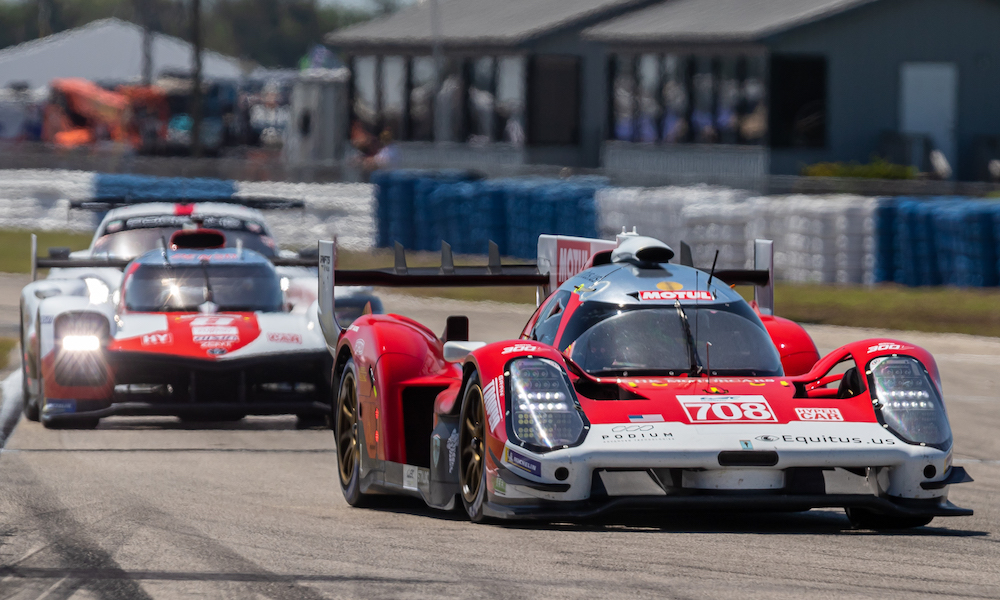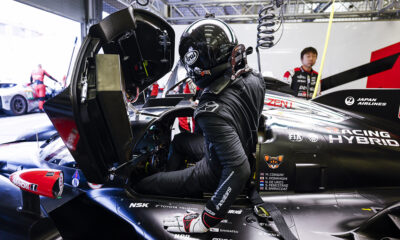The FIA World Endurance Championship has defined the Hypercar class Balance of Performance for the first four rounds of the season including the 24 Hours of Le Mans.
A document published on Wednesday shows two BoP tables, with one covering next weekend’s 1000 Miles of Sebring and the other accounting for the next three races.
Sportscar365 understands that the data in the table for Portimao, Spa and Le Mans is fixed, meaning that it won’t be influenced by the Sebring outcome. The BoP document states that the BoP information is applicable from now “until further notice”.
Sebring will mark the first time that LMH cars — which are either four-wheel-drive hybrid or rear-wheel-drive non-hybrid — will race against the rear-axle hybrid LMDhs.
The BoP tables include different parameters such as minimum weights, maximum power outputs and energy usage limits over the course of a stint.
For Sebring, the three hybrid-powered LMH cars are the heaviest, with the Toyota GR010 Hybrid sitting at the top of the scale with a minimum weight of 1062 kg.
Last year’s world title-winning car, which has been updated for the coming season, is followed by the Ferrari 499P at 1057 kg and the Peugeot 9X8 at 1049 kg.
The Porsche 963 will be the heaviest LMDh car at 1048 kg, with the Cadillac V-Series.R sitting 10 kg lighter. The two lightest cars are the non-hybrid LMHs from Glickenhaus and Vanwall at the lowest permitted weight of 1030 kg.
For Portimao, Spa and Le Mans, the two non-hybrid LMHs will go unchanged but the other vehicles will have reduced minimum weights. In the most significant difference, the Ferrari and Toyota will be able to run 17 kg and 19 kg lighter respectively.
The Peugeot will be 7 kg lighter, while the LMDh machinery from Porsche and Cadillac will have 3 kg to shed after Sebring.
The power outputs are similar for the season-opener with all cars fitting within a range of about 15 horsepower.
The Glickenhaus 007 Pipo has the highest figure of 520 kW (almost 700 hp) while the Vanwall Vandervell 680 has the lowest maximum output of 511 kW (685 hp).
The notable changes after Sebring are set to be a 6 kW (8 hp) reduction for the Ferrari and a reduction of just under 7 hp for the Toyota.
Since the final round of the previous season in Bahrain, the Toyota has received an additional 12 megajoules of energy per stint, while the Peugeot has gained 1 MJ.
However, between the Sebring and the three European races the Toyota and Ferrari will take a 9 MJ reduction while the others are set for minute downward adjustments.
Additionally, the Peugeot will be able to activate its electric motor at 150 km/h while the Toyota and Ferrari must wait until 190 km/h before doing the same.
This is because the hybrid deployment speed is connected to tire size: the Toyota and Ferrari have different-sized Michelin tires on the front and rear whereas the Peugeot uses the same size all around.
Both Hypercar BoP tables also include an identical new column stating an extra docking time that each team must observe when refueling. This has been set at 1.2 seconds for the LMH hybrids, 1 second for the LMDhs and zero seconds for the non-hybrid LMHs.
It is understood that the Sebring BoP numbers are applicable for both this weekend’s official Prologue test and the race, with no changes permitted between the two events.
Wednesday’s BoP announcement breaks from the norm of the FIA publishing updates on a race-by-race basis.
Sebring BoP Defined for GTE-Am
GTE-Am is now the only other WEC class to have a BoP system, following the conclusion of GTE-Pro at the end of last year.
For Sebring, the Aston Martin Vantage GTE will start considerably lighter than its rivals from Ferrari, Porsche and Chevrolet. The British machine has been set at 1245 kg, which is 18 kg lighter than the next-heaviest car which is the Ferrari 488 GTE Evo.
The Chevrolet Corvette C8.R and Porsche 911 RSR-19 are similarly placed to the Ferrari at 1265 kg and 1269 kg respectively.
The Aston has the smallest fuel volume of the four GTE cars, with its 88 liters going up against the 89 liters of the Ferrari, 95 liters of the Corvette and 101 liters of the Porsche.
Chevrolet and Porsche have been given air restrictors of 41.3 mm and 30.6 mm diameters for their naturally-aspirated cars, while turbo boost pressure levels have been defined for the Ferrari and Aston.
The minimum weights in the GTE-Am field will diverge during the season — except for Le Mans — when the returning per-car success ballast system comes into effect.
























